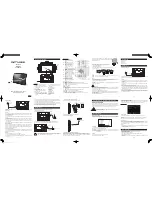
100554 - 3500W WIRELESS START GENERATOR
CONTROLS AND FEATURES
14
Wireless Remote Control
This generator is equipped with a wireless remote control
system for starting and stopping. The system consists of (5)
main components:
1. Receiver Control Module (RCM)
2. Remote Control
3. Battery Switch
4. Ignition Switch
5. Auto-Choke
The Remote Control functions are enabled when:
1. The Ignition Switch is in the “ON” position, AND
2. The Battery Switch is in the “ON” position.
The Remote Control functions are disabled if either of the above
conditions is not met.
To start the generator wirelessly, press the “START” button
on the Remote Control one time. The engine will attempt to
start (6) times. The RCM controls the Auto-Choke during each
attempt to start. If the generator does not start, call Champion
Customer Care team for assistance at 1-877-338-0999.
To stop the generator wirelessly, press the “STOP” button on
the Remote Control one time.
Remote Control Power Consumption
While the Ignition Switch is in the “ON” position, the RCM is
active and waiting for a remote signal. This function requires
electrical current from the battery. If the Ignition Switch is left
in the “ON” position for extended periods (several weeks), the
battery can be completely drained.
Moving the Ignition Switch to the “OFF” position disables the
Remote functions, but the RCM still consumes approximately
2 mA from the battery.
To prevent battery drain, press the Battery Switch to the “OFF”
position. This disconnects power to the RCM so there is no
current draw on the battery.
Control Panel Load Management
When the generator initially starts wirelessly, no voltage is
supplied to the Control Panel for approximately 15 seconds. This
allows the engine to reach full speed before electrical loads are
applied to the generator.
When the generator is stopped wirelessly, the voltage to the
Control Panel is immediately turned off. Then the engine stops
approximately 5 seconds after the “STOP” button on the
Remote Control is pressed. Turning the Control Panel voltage
off before the engine shutdown protects connected appliances
from being damaged by non-60 Hz voltage while the generator
coasts to a stop.
The on/off voltage delay at startup and shut down only happen
when the Remote Control is used. There is no voltage delay
when the push-button electric start or recoil start method is
used.
When the push-button electric start or recoil start method is
used, the operator must be sure all electrical loads (appliances)
are turned OFF during startup and shutdown. Damage to the
generator or the attached appliances can be caused by starting
or stopping the generator while appliances are plugged in and
turned ON.
FCC Statement for Remote Control Device
1. This device complies with Part 15 of the FCC Rules.
Operation is subject to the following two conditions:
1a. This device may not cause harmful interference.
1b. This device must accept any interference received,
including interference that may cause undesired
operation.
2. Changes or modifications not expressly approved by the
party responsible for compliance could void the user’s
authority to operate the equipment.
!
NOTICE
This equipment has been tested and found to comply with
the limits for a Class B digital device, pursuant to Part 15
of the FCC Rules. These limits are designed to provide
reasonable protection against harmful interference in a
residential installation. This equipment generates uses and
can radiate radio frequency energy and, if not installed
and used in accordance with the instructions, may cause
harmful interference to radio communications. However,
there is no guarantee that interference will not occur in a
particular installation. If this equipment does cause harmful
interference to radio or television reception, which can be
determined by turning the equipment off and on, the user is
encouraged to try to correct the interference by one or more
of the following measures:
–
Reorient or relocate the receiving antenna.
–
Increase the separation between the equipment and
receiver.
–
Connect the equipment into an outlet on a circuit
different from that to which the receiver is connected.
Consult dealer or an experienced radio/TV technician for help.















































